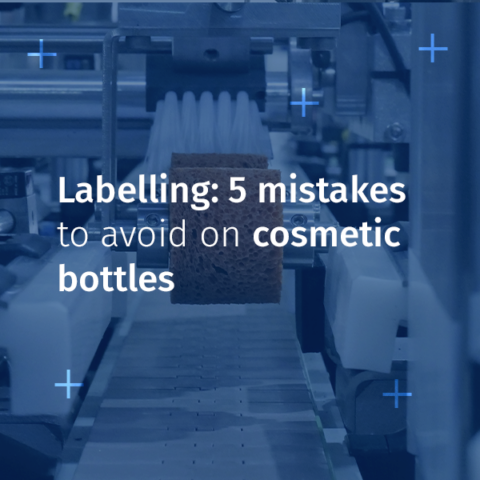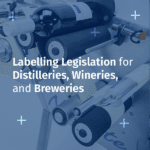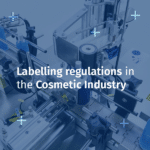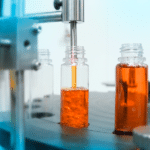In the cosmetics industry, labelling goes far beyond sticking a label onto a bottle: it is part of your marketing strategy, regulatory compliance, and customer experience.
Whether you are producing serums, creams, lotions or balms, the way your bottle is presented often plays a decisive role in the purchasing decision.
A poorly applied, misaligned, or illegible label can harm brand image and compromise legal compliance particularly in a sector where consumers pay close attention to detail.
Here are the five most common mistakes made when labelling cosmetic bottles, how to avoid them, and which technical solutions (such as those offered by CDA) can help you improve your packaging process.
Mistake #1: Misaligned Labels
The issue
A skewed or off-centre label immediately catches the eye and creates an impression of carelessness. In cosmetics, where aesthetics are crucial, this is a serious flaw.
Frequent causes
- Poorly positioned sensor
- Incorrect settings for the bottle dimensions
- Miscalibrated conveyor speed
Consequences
- Damage to brand image
- Risk of non-compliance if regulatory information is difficult to read
- Increased waste and higher production costs
CDA solutions
- Ninette Auto: a semi-automatic labeller, perfect for small runs, ensuring accurate application of two adhesive labels on cylindrical products in a single operation.
- Ninon 1500: an automatic labeller for high-speed lines, with fine adjustments to guarantee perfectly aligned labels on cylindrical products.
- Ninon Mix: designed for cylindrical, square, oval, or conical bottles, offering maximum flexibility without compromising precision.
Learn more about CDA’s automatic and semi-automatic labellers.
Mistake #2: Incorrect Label tension
The issue
If tension is too weak, labels may crease or bubble; if it is too strong, they can tear or distort.
Frequent causes
- Incorrect adjustment
- Variations in label quality or thickness
- Poor machine-to-label compatibility
Consequences
- Visible aesthetic flaws
- Reduced legibility of text or barcodes
- Higher waste and longer production times
CDA solutions
CDA labellers allow simple but precise adjustments so operators can easily adapt tension to different reels.
Mistake #3: Labels not sized for the bottle
The issue
Using labels that are too large, too small, or ill-fitted to the container results in poor aesthetics and sometimes adhesion problems.
Frequent causes
- Incorrect consideration of bottle dimensions during design
- No machine testing before production
- Supplier changes without prior checks
CDA solutions
- Testing with your own samples in CDA workshops to validate feasibility
- Quick and easy adjustments to adapt the machine to different bottle formats
Mistake #4: Inappropriate adhesive or label material
The issue
Some cosmetic products may affect the adhesive, leading to labels peeling off over time.
Solutions
- Choose labels resistant to moisture, oils, and temperature variations
- Ensure compatibility with surfaces such as glass, PET plastic, or aluminium
Mistake #5: Lack of quality control after labelling
The issue
Even with optimal settings, occasional errors can still occur.
CDA solutions
- Integrate camera-based inspection systems to check label alignment and presence
- Use CDA’s Solo or Ninon labellers with detection and automatic ejection modules for non-compliant bottles
Best practices to prevent these errors
- Ask your machine supplier to test with your samples
- Train operators on machine handling and adjustment
- Carry out regular maintenance, as some consumables lose efficiency over time
Why choose a CDA machine for labelling cosmetic bottles?
At CDA, we offer solutions tailored to every production scale:
- Semi-automatic: Ninette 1, Ninette 2, Ninette Auto, ideal for small runs or new brands
- Automatic: Ninon 1500, Ninon Konic, Ninon Mix, for high-speed, flexible, and precise production lines
Labelling a cosmetic bottle is a decisive step influencing both perception and compliance. By avoiding these five mistakes and investing in an efficient, reliable solution, you guarantee a flawless presentation of your products.
Discover all our labelling machines as well as our filling and capping solutions for cosmetics
For further guidance, CDA also provides a complete adhesive labelling guide with practical tips, best practices, and advice to optimise your operations.
FAQ
What is the price of a cosmetic bottle labeller?
Prices depend on production speed, container format, and required options. Semi-automatic machines start from a few thousand euros, while fully automatic labellers for industrial lines can cost several tens of thousands.
Do I need a specific labeller for round and flat bottles?
Yes. Some labellers are versatile and can handle round, flat, or oval containers. However, for maximum accuracy and efficiency, it is best to use a machine designed for your most common bottle shape.
How can I ensure compliance of cosmetic labels?
Cosmetic labels must include ingredients, batch number, expiry date, product function, and usage precautions. Automatic labellers ensure consistent, legible application that supports regulatory compliance.
Capper or crimper: which is best for cosmetics?
It depends on the closure type: cappers are used for screw caps or snap-on lids, while crimpers are designed for hermetically sealing metal containers (e.g. jars, aerosols).










